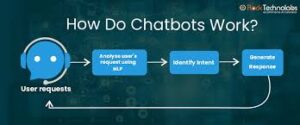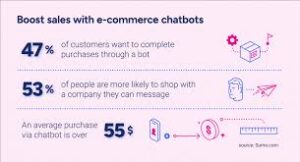Customer experience reigns supreme. Gone are the days of tedious phone calls and lengthy email exchanges; the future of online sales is now being driven by a new generation of intelligent, conversational interfaces – ecommerce chatbots. These innovative digital assistants are revolutionizing the way customers interact with online stores, providing instant support, personalized recommendations, and seamless transactions. Artificial intelligence and machine learning, ecommerce chatbots are transforming the online shopping experience, increasing customer satisfaction, and driving revenue for businesses. In this post, we’ll delve into the world of ecommerce chatbots, exploring what they are, how they work, and the incredible benefits they can bring to your online store.
What are E-commerce Chatbots?

Imagine a friendly, helpful assistant readily available 24/7 on your website, guiding you through product discovery, answering questions, and even assisting with checkout. That’s the essence of an e-commerce chatbot. These AI-powered programs simulate conversations with website visitors, offering a range of functionalities:
Answering Frequently Asked Questions (FAQs): Chatbots can be programmed to answer a vast array of common customer inquiries, from product specifications and sizing charts to return policies and shipping information. This frees up human customer service representatives for more complex issues.
Product recommendations: By leveraging user data and browsing behavior, chatbots can personalize product recommendations, suggesting items that align with the customer’s interests.
Order tracking: Gone are the days of endlessly refreshing order tracking pages. Chatbots can provide real-time updates on order status, delivery estimates, and any potential issues.
24/7 support: Unlike human customer service representatives, chatbots are available around the clock, ensuring that customers receive assistance whenever they need it.
Lead generation: Chatbots can engage visitors in conversations, capturing valuable information like email addresses and preferences, which can be used for future marketing campaigns.
The benefits of chatbots for e-commerce businesses:
The advent of ecommerce chatbots has revolutionized the online shopping experience, and the benefits they bring to online stores are undeniable.
Enhanced customer experience: Chatbots provide immediate assistance and personalized recommendations, leading to a more satisfying shopping experience for customers.
Increased sales and conversions: Chatbots can guide users through the purchase process, address concerns, and ultimately nudge them towards conversion.
Reduced customer service costs: By handling simple inquiries and FAQs, chatbots free up human customer service resources to focus on more complex issues.
24/7 availability: Customers can receive support anytime, regardless of time zone or business hours.
Data collection and insights: Chatbot interactions can provide valuable customer data about preferences, buying habits, and pain points, which can inform marketing strategies and product development.
How chatbots work

At the core of a chatbot lies a combination of Artificial Intelligence (AI) and Machine Learning (ML) technologies.
AI: This broad field of computer science focuses on creating intelligent machines that can simulate human cognitive functions. Chatbots leverage AI techniques like natural language processing (NLP) to understand and respond to user input.
Machine Learning (ML): A subset of AI, ML allows chatbots to learn and improve over time. By analyzing vast amounts of data, including past conversations and user interactions, ML algorithms enable chatbots to become more adept at understanding natural language, recognizing user intent, and delivering increasingly accurate responses.
Understanding user input: Natural Language Processing (NLP)
Intent recognition: This crucial NLP function involves deciphering the user’s underlying goal or question within their message. For instance, the chatbot needs to understand if the user is asking a question about product features (informational intent), seeking help with checkout (transactional intent), or simply expressing frustration (sentiment analysis).
Entity recognition: NLP also allows chatbots to identify specific entities within a user’s message. These entities could be product names, order numbers, or shipping details. By recognizing these entities, the chatbot can tailor its response accordingly.
Crafting a response: Dialogue management
Decision trees: These flowcharts map out potential conversation paths based on user input. The chatbot navigates the decision tree, selecting the most appropriate response based on the user’s intent and the conversation history.
Response generation: Once the chatbot has determined the best course of action, it formulates a response. This might involve retrieving pre-programmed responses from a vast knowledge base or dynamically generating a response using NLP techniques.
Continuous learning and improvement
Training data: Chatbots are trained on massive datasets of text and code, including past conversations, customer service transcripts, and product information. This training data equips the chatbot to recognize patterns and understand the nuances of human language.
Feedback mechanisms: Some chatbots incorporate feedback mechanisms that allow users to rate their satisfaction with the interaction. This feedback is fed back into the ML algorithms, enabling the chatbot to continuously learn and improve its response accuracy over time.
Integration channels: Where do chatbots live?
E-commerce chatbots can be integrated into various platforms where customers interact with your brand:
Website chat: A common integration point, allowing customers to chat with the virtual assistant directly on your website.
Social meedia platforms: Chatbots can be seamlessly embedded within popular social media platforms like Facebook Messenger or Instagram, providing customer support within familiar interfaces.
Mobile Apps: Integrating chatbots within your brand’s mobile app can offer on-the-go support and product recommendations to users.
How e-commerce chatbots are used in action
To better understand the diverse applications of e-commerce chatbots, let’s explore some real-world examples:
Sephora beauty chatbot: The Sephora chatbot allows users to take a short quiz to determine their skin type and preferences. Based on the results, the chatbot recommends personalized product suggestions, replicating the experience of having a helpful beauty consultant at your fingertips.
eBay shopBot: This virtual shopping assistant works seamlessly through Facebook Messenger. It answers customer questions, tracks orders, and even provides personalized shopping recommendations, all within the familiar Messenger interface.
H&M’s “Ask Anna” chatbot: This friendly AI assistant guides users through H&M’s vast clothing selection. “Ask Anna” can answer questions about sizing, styles, and current promotions, streamlining the product discovery process for shoppers.
Implementing ecommerce chatbots into your online store

As the world of ecommerce continues to evolve, the integration of chatbots into online stores is becoming a crucial aspect of providing exceptional customer service. Implementing ecommerce chatbots into your online store can be a game-changer, allowing you to automate tasks, provide 24/7 support, and even drive sales. But how do you get started? First, you’ll need to choose a chatbot platform that integrates with your ecommerce platform. From there, you can customize your chatbot to fit your brand’s unique voice and style. This may involve setting up conversational flows, designing the chatbot’s user interface, and integrating payment gateways. By doing so, you’ll be able to create a seamless and personalized shopping experience for your customers. Additionally, you can also use chatbots to proactively engage with customers, offer personalized product recommendations, and even help with order tracking and returns. With the right implementation, ecommerce chatbots can become a powerful tool in your online store’s arsenal, helping to drive conversions, increase customer satisfaction, and ultimately, boost your bottom line.
The future of e-commerce chatbots
As AI technology continues to evolve, so too will the capabilities of e-commerce chatbots. Expect to see chatbots with even more sophisticated natural language processing abilities, allowing for more nuanced and personalized conversations. Additionally, seamless integration with social media platforms will further enhance the customer experience, offering a consistent and convenient way to interact with brands.
Conclusion
As the world of ecommerce continues to evolve at breakneck speed, one thing is clear: chatbots are here to stay. These innovative tools have revolutionized the way online businesses interact with their customers, providing personalized support, streamlining transactions, and boosting sales. Automating routine tasks, ecommerce chatbots free up valuable time for human customer support agents to focus on complex, high-value issues. The result is a seamless, omnichannel shopping experience that leaves customers feeling valued, supported, and eager to return. Whether you’re a seasoned ecommerce pro or just starting out, it’s time to join the chatbot revolution and unlock the full potential of your online store. With the power of chatbots on your side, the possibilities are endless – and the future of online sales has never looked brighter.
